Strategies to Reduce Hospital Healthcare Costs by Cutting Down on Unnecessary Tests
VerifiedAdded on 2023/06/15
|17
|2124
|173
AI Summary
This presentation discusses strategies to reduce hospital healthcare costs by cutting down on unnecessary tests. It provides insights on three identified thesis papers related to the topic and their pros and cons. The presentation also discusses the feasibility and viability of the resources and the strengths and weaknesses of each thesis. The relevance of each thesis to the practicum project is also discussed. The presentation concludes with a personal choice for a dissertation topic and a list of references.
Contribute Materials
Your contribution can guide someone’s learning journey. Share your
documents today.

N A M E O F T H E S T U D E N T :
N A M E O F T H E U N I V E R S I T Y:
THESIS CRITIQUE POWER POINT
PRESENTATION
N A M E O F T H E U N I V E R S I T Y:
THESIS CRITIQUE POWER POINT
PRESENTATION
Secure Best Marks with AI Grader
Need help grading? Try our AI Grader for instant feedback on your assignments.
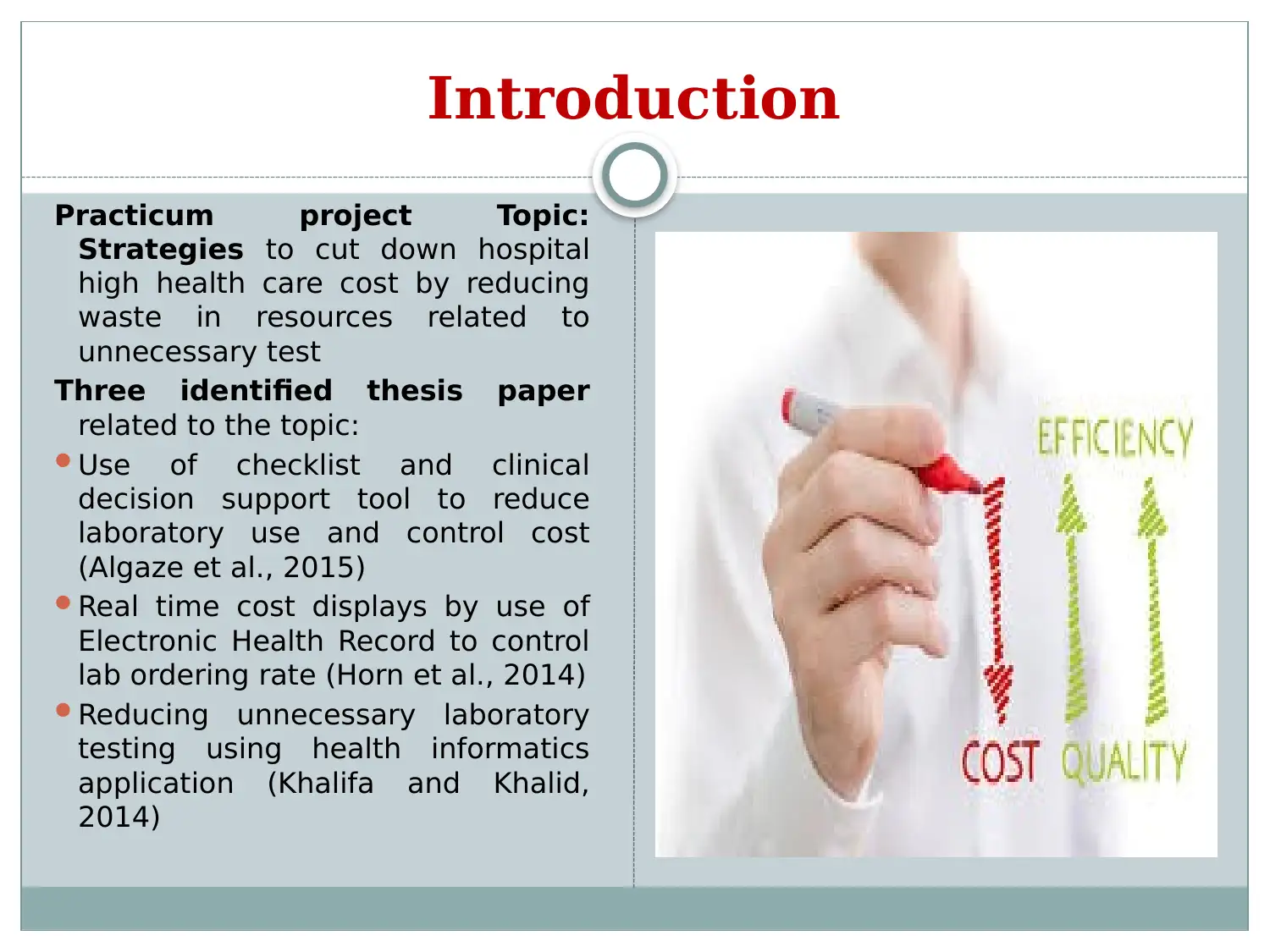
Introduction
Practicum project Topic:
Strategies to cut down hospital
high health care cost by reducing
waste in resources related to
unnecessary test
Three identified thesis paper
related to the topic:
Use of checklist and clinical
decision support tool to reduce
laboratory use and control cost
(Algaze et al., 2015)
Real time cost displays by use of
Electronic Health Record to control
lab ordering rate (Horn et al., 2014)
Reducing unnecessary laboratory
testing using health informatics
application (Khalifa and Khalid,
2014)
Practicum project Topic:
Strategies to cut down hospital
high health care cost by reducing
waste in resources related to
unnecessary test
Three identified thesis paper
related to the topic:
Use of checklist and clinical
decision support tool to reduce
laboratory use and control cost
(Algaze et al., 2015)
Real time cost displays by use of
Electronic Health Record to control
lab ordering rate (Horn et al., 2014)
Reducing unnecessary laboratory
testing using health informatics
application (Khalifa and Khalid,
2014)
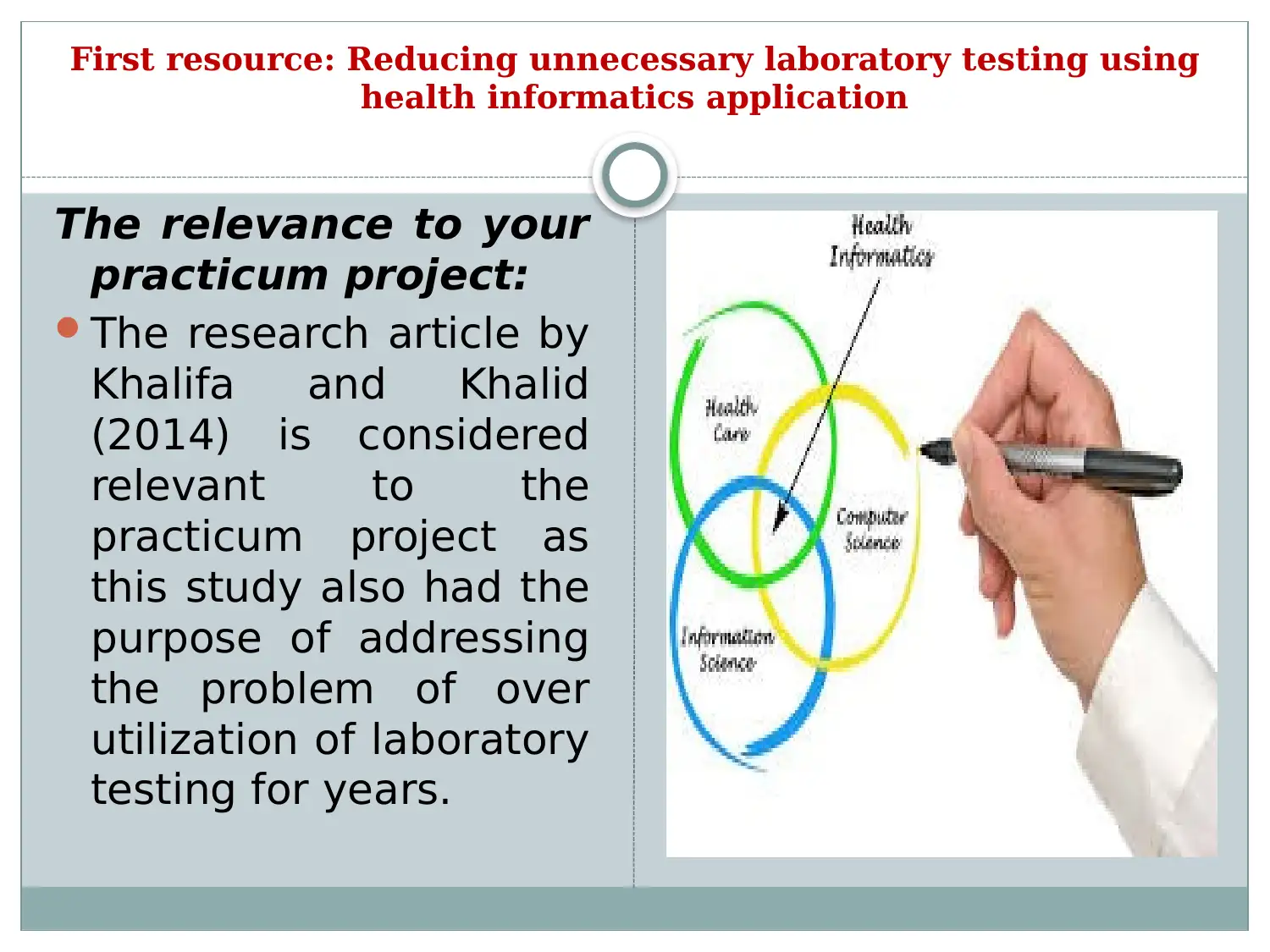
First resource: Reducing unnecessary laboratory testing using
health informatics application
The relevance to your
practicum project:
The research article by
Khalifa and Khalid
(2014) is considered
relevant to the
practicum project as
this study also had the
purpose of addressing
the problem of over
utilization of laboratory
testing for years.
health informatics application
The relevance to your
practicum project:
The research article by
Khalifa and Khalid
(2014) is considered
relevant to the
practicum project as
this study also had the
purpose of addressing
the problem of over
utilization of laboratory
testing for years.
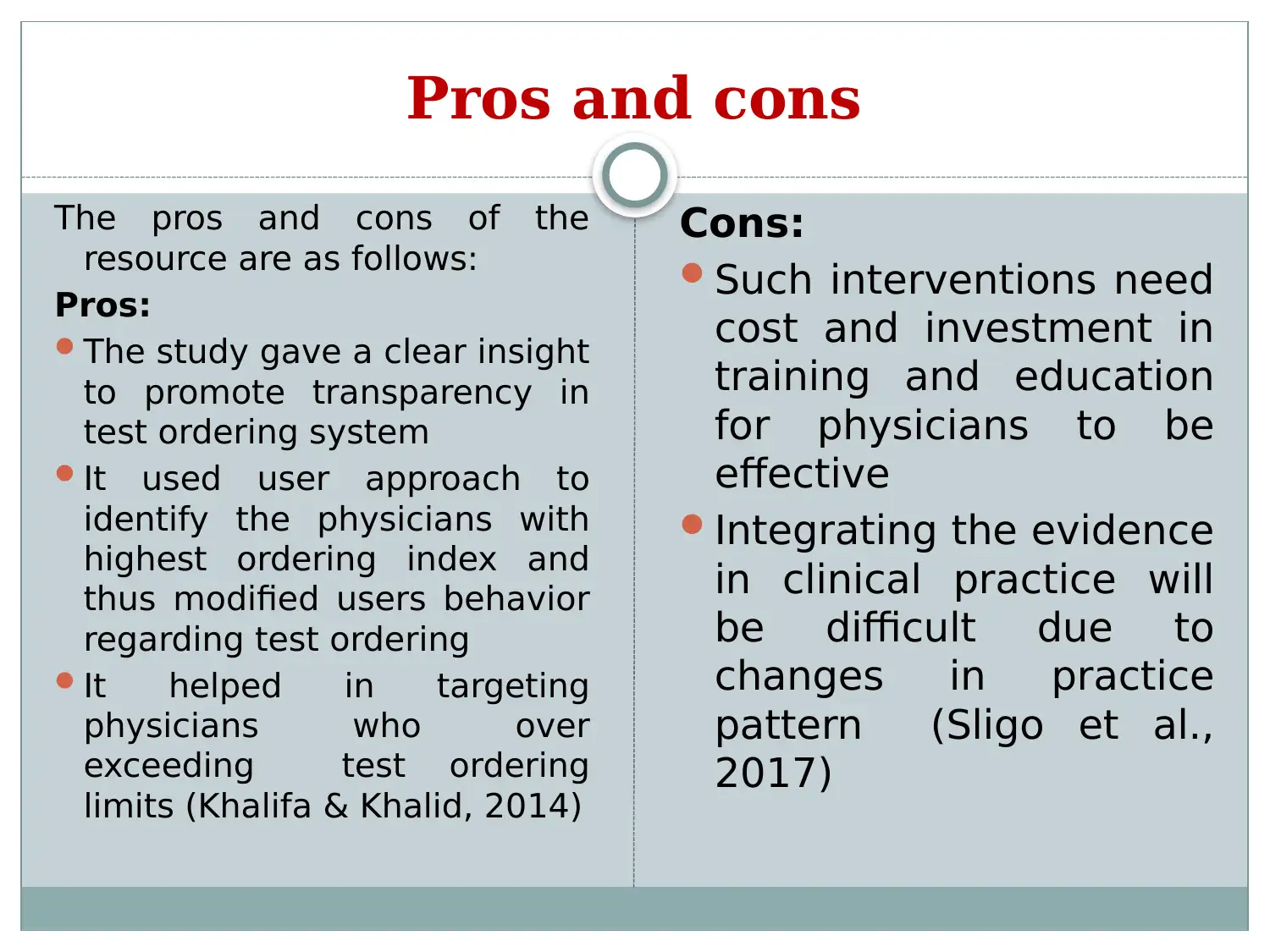
Pros and cons
The pros and cons of the
resource are as follows:
Pros:
The study gave a clear insight
to promote transparency in
test ordering system
It used user approach to
identify the physicians with
highest ordering index and
thus modified users behavior
regarding test ordering
It helped in targeting
physicians who over
exceeding test ordering
limits (Khalifa & Khalid, 2014)
Cons:
Such interventions need
cost and investment in
training and education
for physicians to be
effective
Integrating the evidence
in clinical practice will
be difficult due to
changes in practice
pattern (Sligo et al.,
2017)
The pros and cons of the
resource are as follows:
Pros:
The study gave a clear insight
to promote transparency in
test ordering system
It used user approach to
identify the physicians with
highest ordering index and
thus modified users behavior
regarding test ordering
It helped in targeting
physicians who over
exceeding test ordering
limits (Khalifa & Khalid, 2014)
Cons:
Such interventions need
cost and investment in
training and education
for physicians to be
effective
Integrating the evidence
in clinical practice will
be difficult due to
changes in practice
pattern (Sligo et al.,
2017)
Secure Best Marks with AI Grader
Need help grading? Try our AI Grader for instant feedback on your assignments.
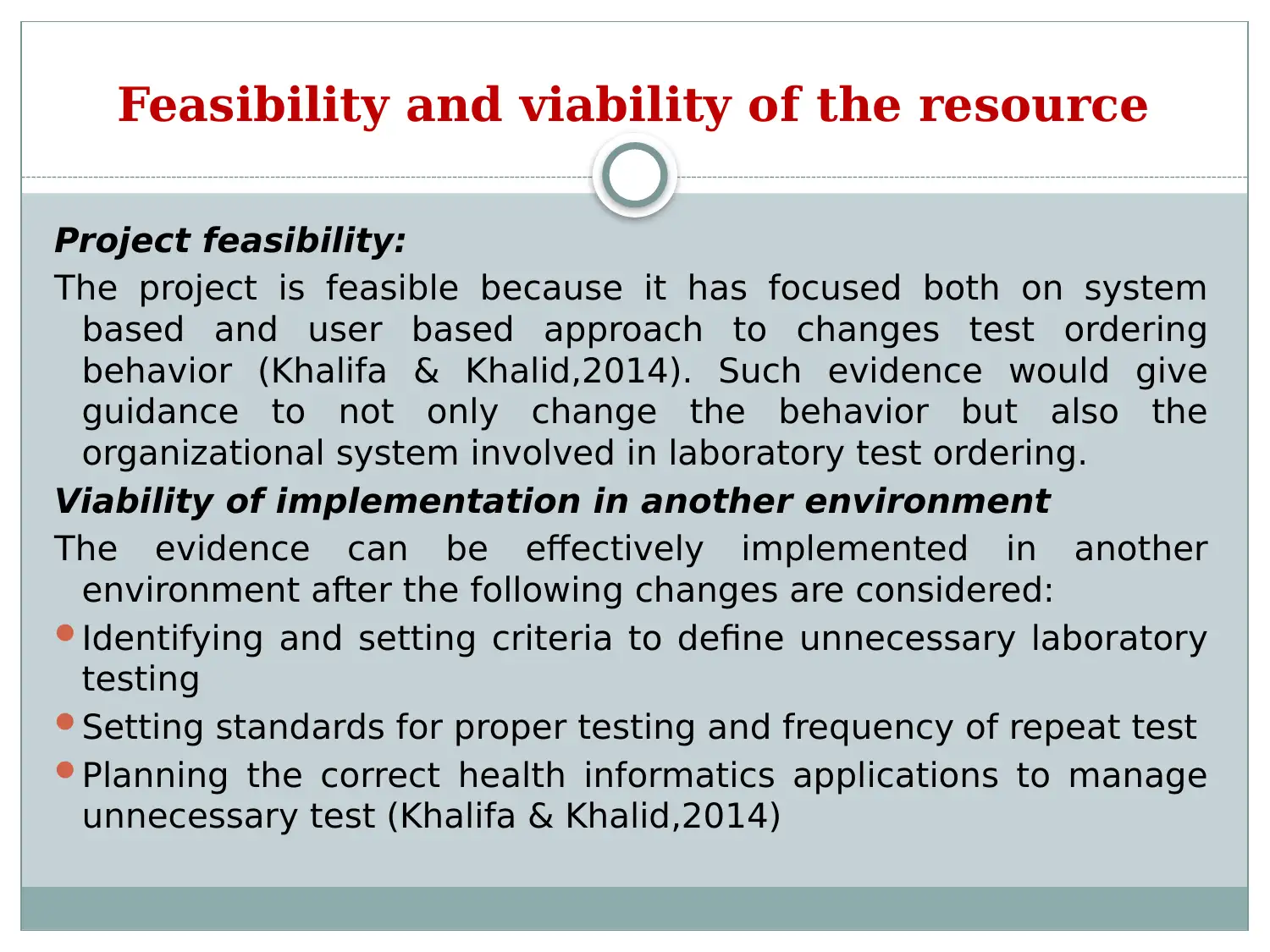
Feasibility and viability of the resource
Project feasibility:
The project is feasible because it has focused both on system
based and user based approach to changes test ordering
behavior (Khalifa & Khalid,2014). Such evidence would give
guidance to not only change the behavior but also the
organizational system involved in laboratory test ordering.
Viability of implementation in another environment
The evidence can be effectively implemented in another
environment after the following changes are considered:
Identifying and setting criteria to define unnecessary laboratory
testing
Setting standards for proper testing and frequency of repeat test
Planning the correct health informatics applications to manage
unnecessary test (Khalifa & Khalid,2014)
Project feasibility:
The project is feasible because it has focused both on system
based and user based approach to changes test ordering
behavior (Khalifa & Khalid,2014). Such evidence would give
guidance to not only change the behavior but also the
organizational system involved in laboratory test ordering.
Viability of implementation in another environment
The evidence can be effectively implemented in another
environment after the following changes are considered:
Identifying and setting criteria to define unnecessary laboratory
testing
Setting standards for proper testing and frequency of repeat test
Planning the correct health informatics applications to manage
unnecessary test (Khalifa & Khalid,2014)
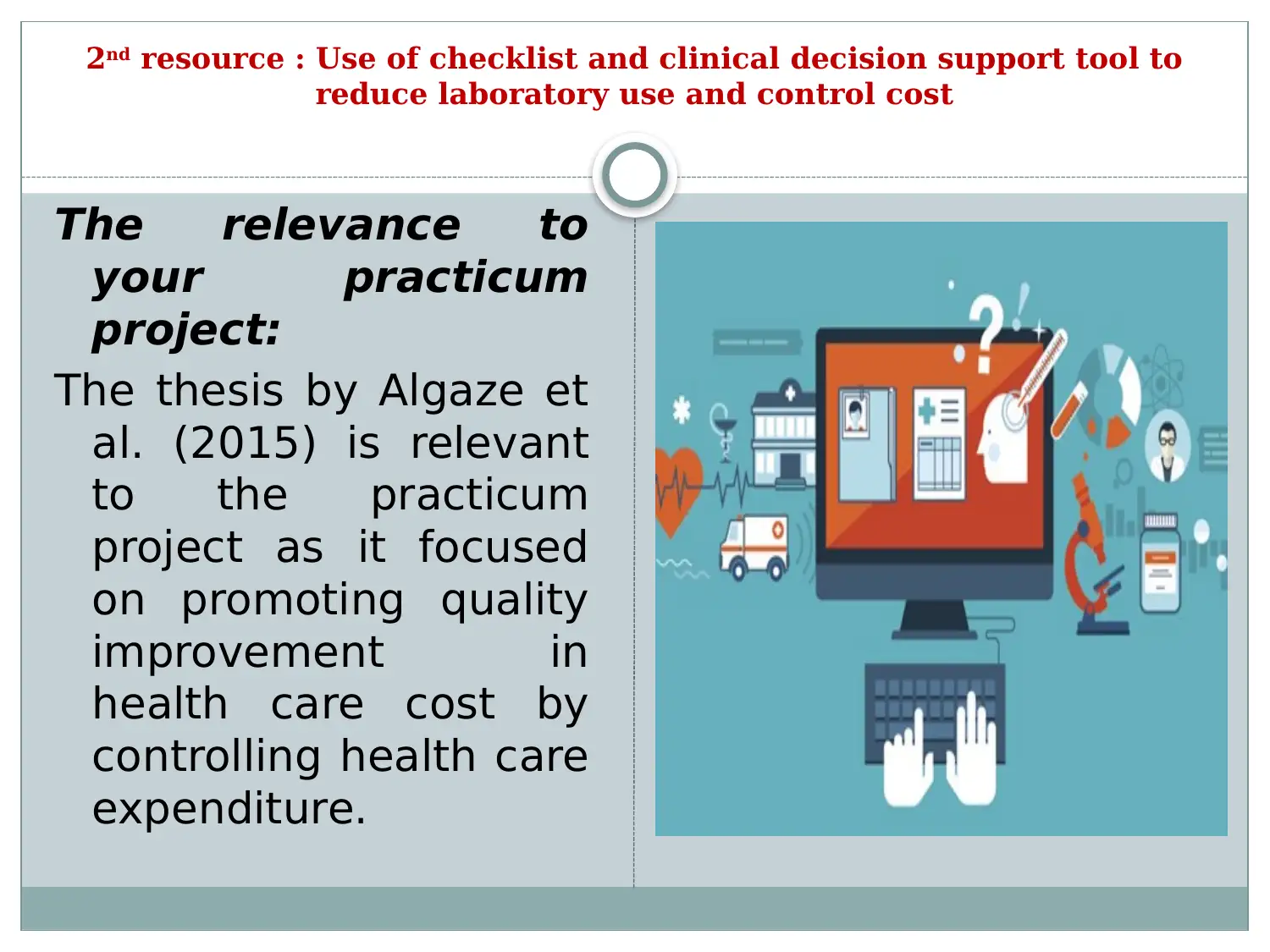
2nd resource : Use of checklist and clinical decision support tool to
reduce laboratory use and control cost
The relevance to
your practicum
project:
The thesis by Algaze et
al. (2015) is relevant
to the practicum
project as it focused
on promoting quality
improvement in
health care cost by
controlling health care
expenditure.
reduce laboratory use and control cost
The relevance to
your practicum
project:
The thesis by Algaze et
al. (2015) is relevant
to the practicum
project as it focused
on promoting quality
improvement in
health care cost by
controlling health care
expenditure.
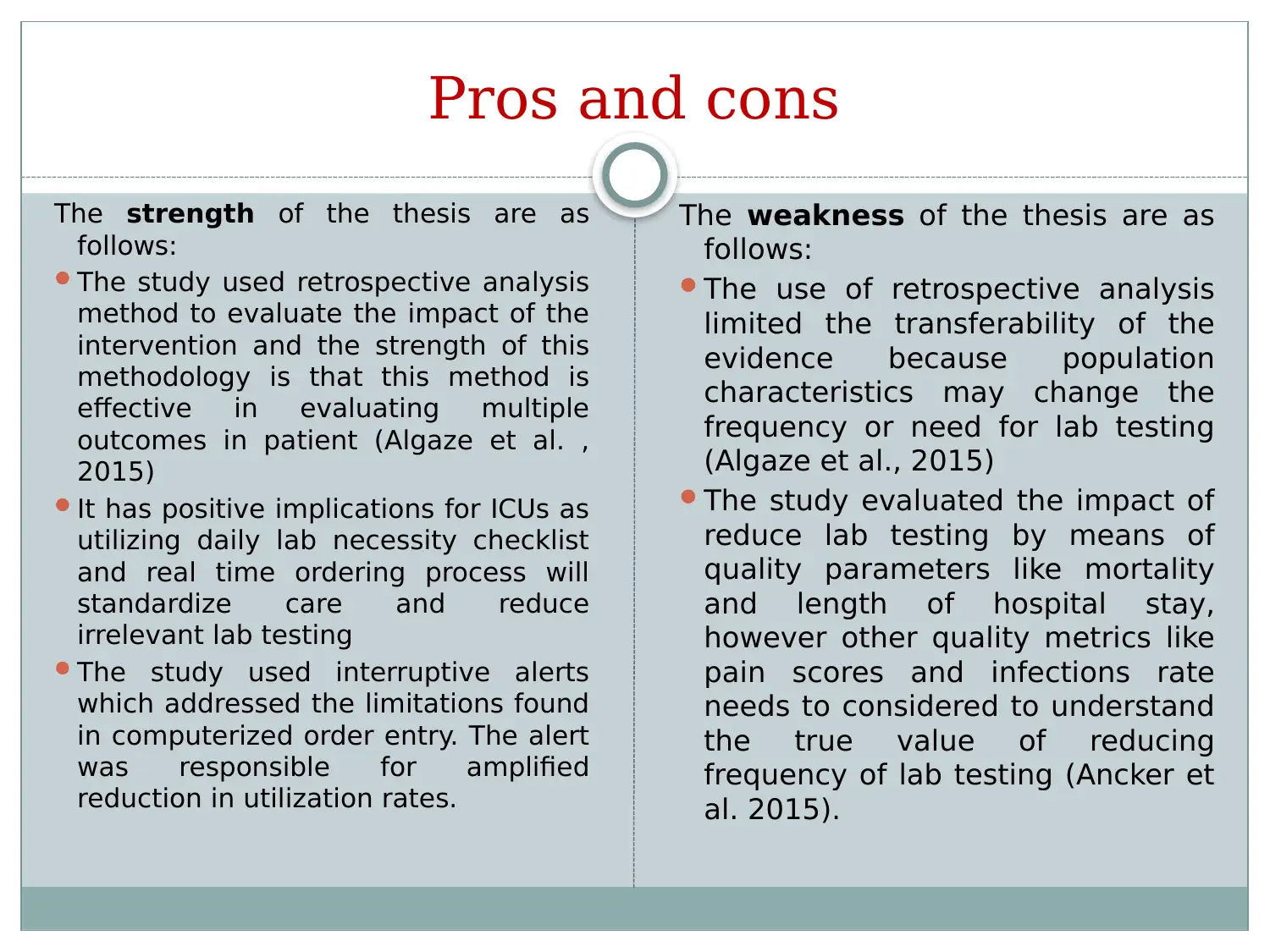
Pros and cons
The strength of the thesis are as
follows:
The study used retrospective analysis
method to evaluate the impact of the
intervention and the strength of this
methodology is that this method is
effective in evaluating multiple
outcomes in patient (Algaze et al. ,
2015)
It has positive implications for ICUs as
utilizing daily lab necessity checklist
and real time ordering process will
standardize care and reduce
irrelevant lab testing
The study used interruptive alerts
which addressed the limitations found
in computerized order entry. The alert
was responsible for amplified
reduction in utilization rates.
The weakness of the thesis are as
follows:
The use of retrospective analysis
limited the transferability of the
evidence because population
characteristics may change the
frequency or need for lab testing
(Algaze et al., 2015)
The study evaluated the impact of
reduce lab testing by means of
quality parameters like mortality
and length of hospital stay,
however other quality metrics like
pain scores and infections rate
needs to considered to understand
the true value of reducing
frequency of lab testing (Ancker et
al. 2015).
The strength of the thesis are as
follows:
The study used retrospective analysis
method to evaluate the impact of the
intervention and the strength of this
methodology is that this method is
effective in evaluating multiple
outcomes in patient (Algaze et al. ,
2015)
It has positive implications for ICUs as
utilizing daily lab necessity checklist
and real time ordering process will
standardize care and reduce
irrelevant lab testing
The study used interruptive alerts
which addressed the limitations found
in computerized order entry. The alert
was responsible for amplified
reduction in utilization rates.
The weakness of the thesis are as
follows:
The use of retrospective analysis
limited the transferability of the
evidence because population
characteristics may change the
frequency or need for lab testing
(Algaze et al., 2015)
The study evaluated the impact of
reduce lab testing by means of
quality parameters like mortality
and length of hospital stay,
however other quality metrics like
pain scores and infections rate
needs to considered to understand
the true value of reducing
frequency of lab testing (Ancker et
al. 2015).
Paraphrase This Document
Need a fresh take? Get an instant paraphrase of this document with our AI Paraphraser
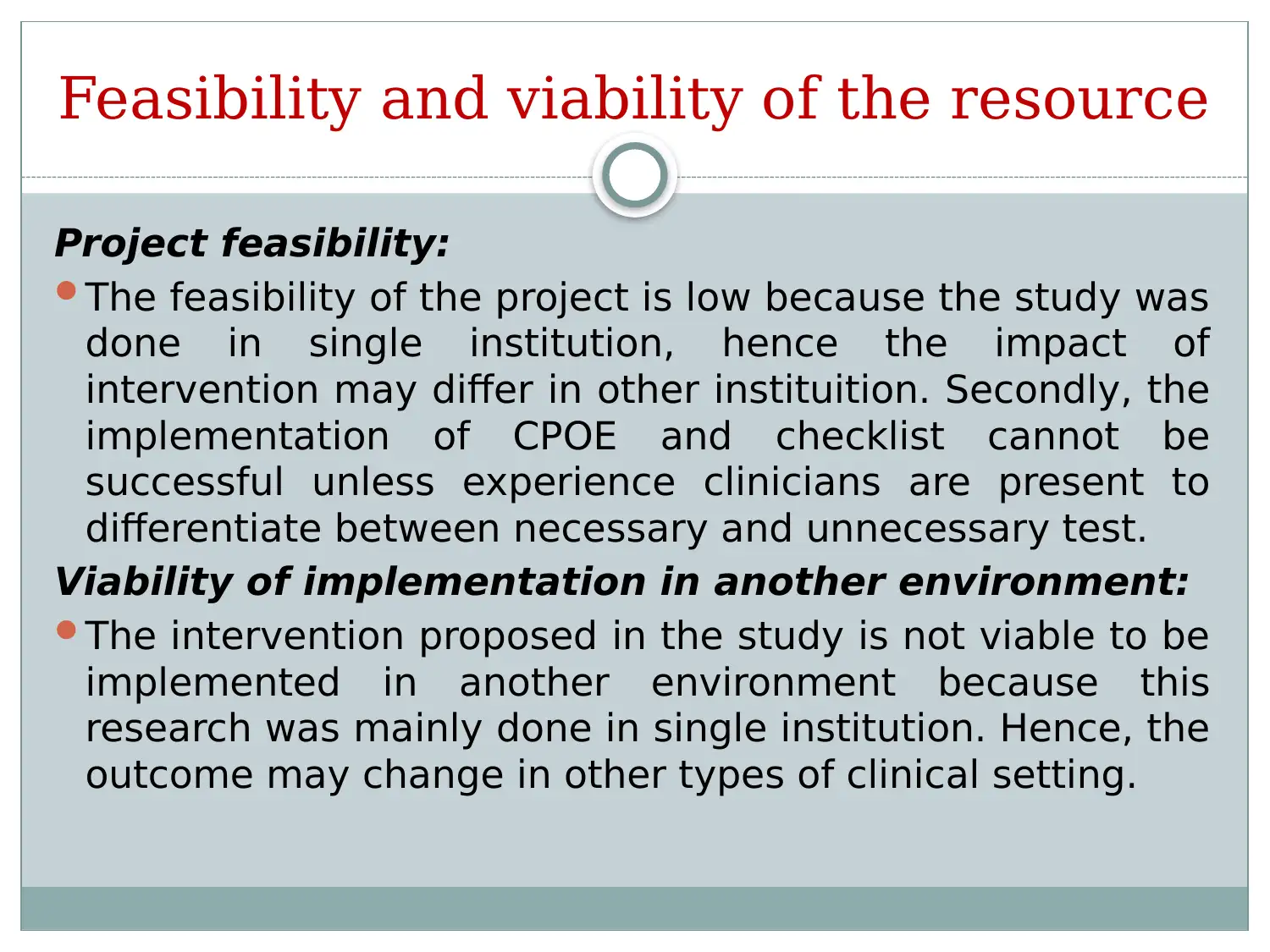
Feasibility and viability of the resource
Project feasibility:
The feasibility of the project is low because the study was
done in single institution, hence the impact of
intervention may differ in other instituition. Secondly, the
implementation of CPOE and checklist cannot be
successful unless experience clinicians are present to
differentiate between necessary and unnecessary test.
Viability of implementation in another environment:
The intervention proposed in the study is not viable to be
implemented in another environment because this
research was mainly done in single institution. Hence, the
outcome may change in other types of clinical setting.
Project feasibility:
The feasibility of the project is low because the study was
done in single institution, hence the impact of
intervention may differ in other instituition. Secondly, the
implementation of CPOE and checklist cannot be
successful unless experience clinicians are present to
differentiate between necessary and unnecessary test.
Viability of implementation in another environment:
The intervention proposed in the study is not viable to be
implemented in another environment because this
research was mainly done in single institution. Hence, the
outcome may change in other types of clinical setting.
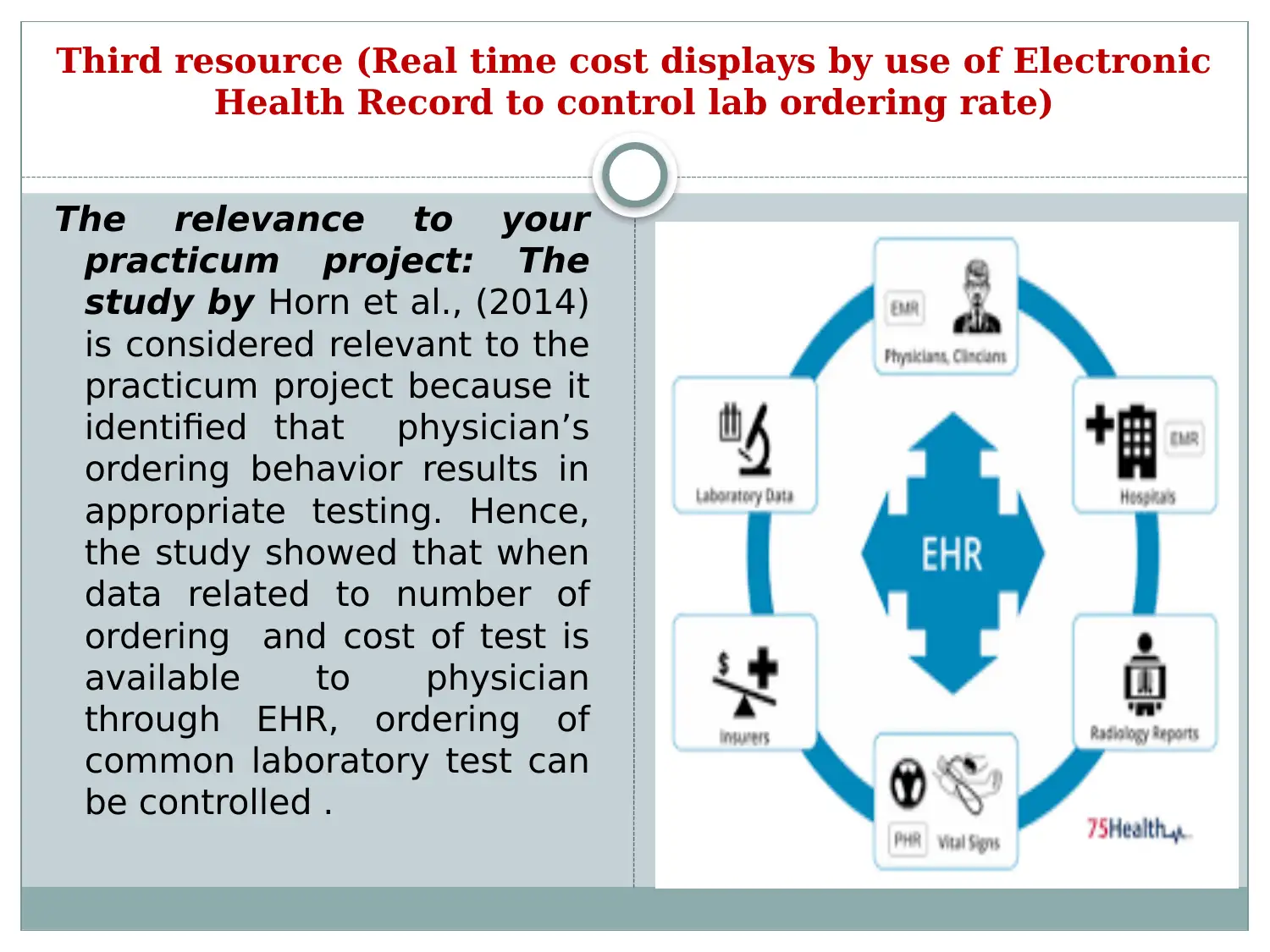
Third resource (Real time cost displays by use of Electronic
Health Record to control lab ordering rate)
The relevance to your
practicum project: The
study by Horn et al., (2014)
is considered relevant to the
practicum project because it
identified that physician’s
ordering behavior results in
appropriate testing. Hence,
the study showed that when
data related to number of
ordering and cost of test is
available to physician
through EHR, ordering of
common laboratory test can
be controlled .
Health Record to control lab ordering rate)
The relevance to your
practicum project: The
study by Horn et al., (2014)
is considered relevant to the
practicum project because it
identified that physician’s
ordering behavior results in
appropriate testing. Hence,
the study showed that when
data related to number of
ordering and cost of test is
available to physician
through EHR, ordering of
common laboratory test can
be controlled .
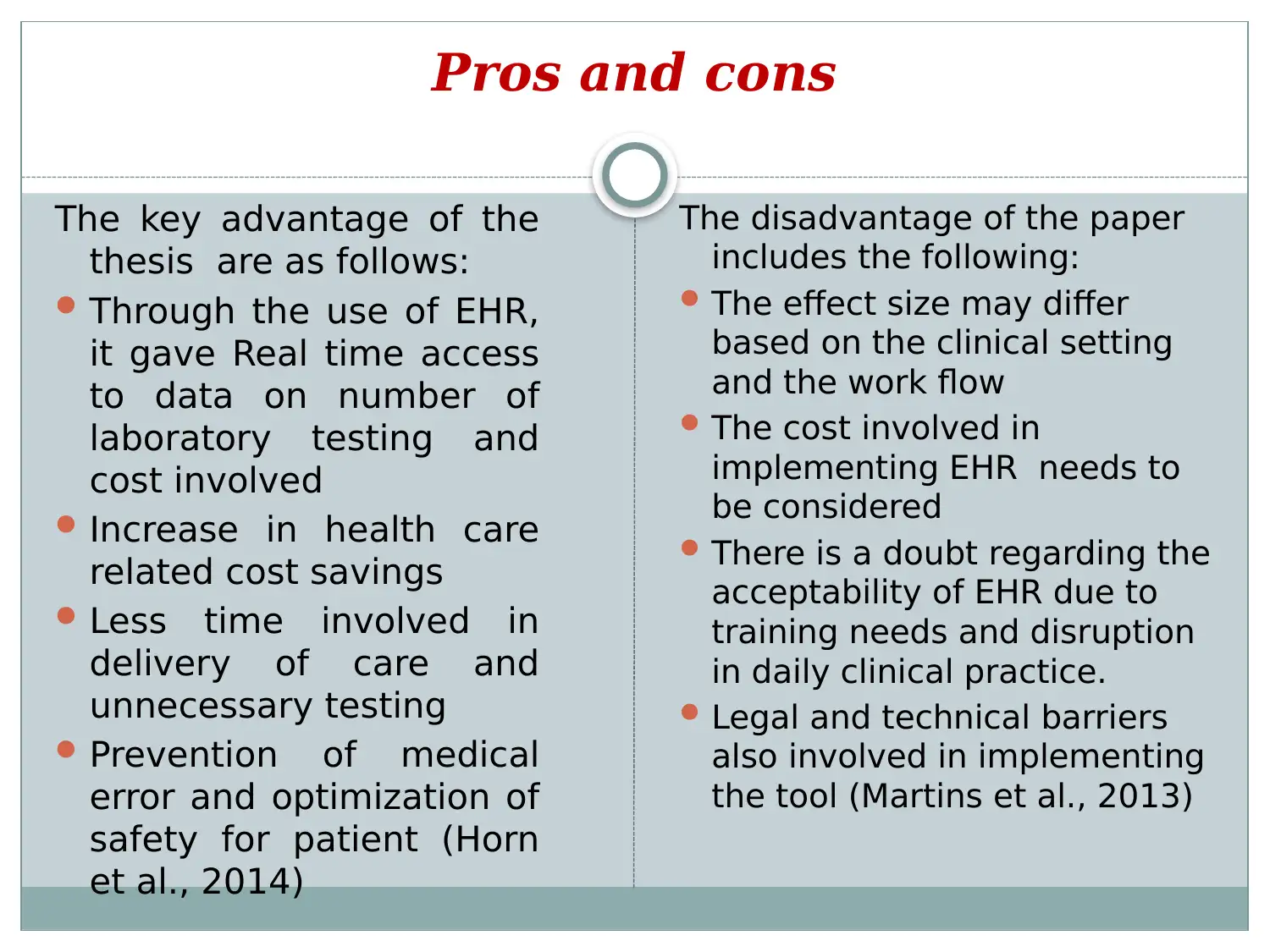
Pros and cons
The key advantage of the
thesis are as follows:
Through the use of EHR,
it gave Real time access
to data on number of
laboratory testing and
cost involved
Increase in health care
related cost savings
Less time involved in
delivery of care and
unnecessary testing
Prevention of medical
error and optimization of
safety for patient (Horn
et al., 2014)
The disadvantage of the paper
includes the following:
The effect size may differ
based on the clinical setting
and the work flow
The cost involved in
implementing EHR needs to
be considered
There is a doubt regarding the
acceptability of EHR due to
training needs and disruption
in daily clinical practice.
Legal and technical barriers
also involved in implementing
the tool (Martins et al., 2013)
The key advantage of the
thesis are as follows:
Through the use of EHR,
it gave Real time access
to data on number of
laboratory testing and
cost involved
Increase in health care
related cost savings
Less time involved in
delivery of care and
unnecessary testing
Prevention of medical
error and optimization of
safety for patient (Horn
et al., 2014)
The disadvantage of the paper
includes the following:
The effect size may differ
based on the clinical setting
and the work flow
The cost involved in
implementing EHR needs to
be considered
There is a doubt regarding the
acceptability of EHR due to
training needs and disruption
in daily clinical practice.
Legal and technical barriers
also involved in implementing
the tool (Martins et al., 2013)
Secure Best Marks with AI Grader
Need help grading? Try our AI Grader for instant feedback on your assignments.
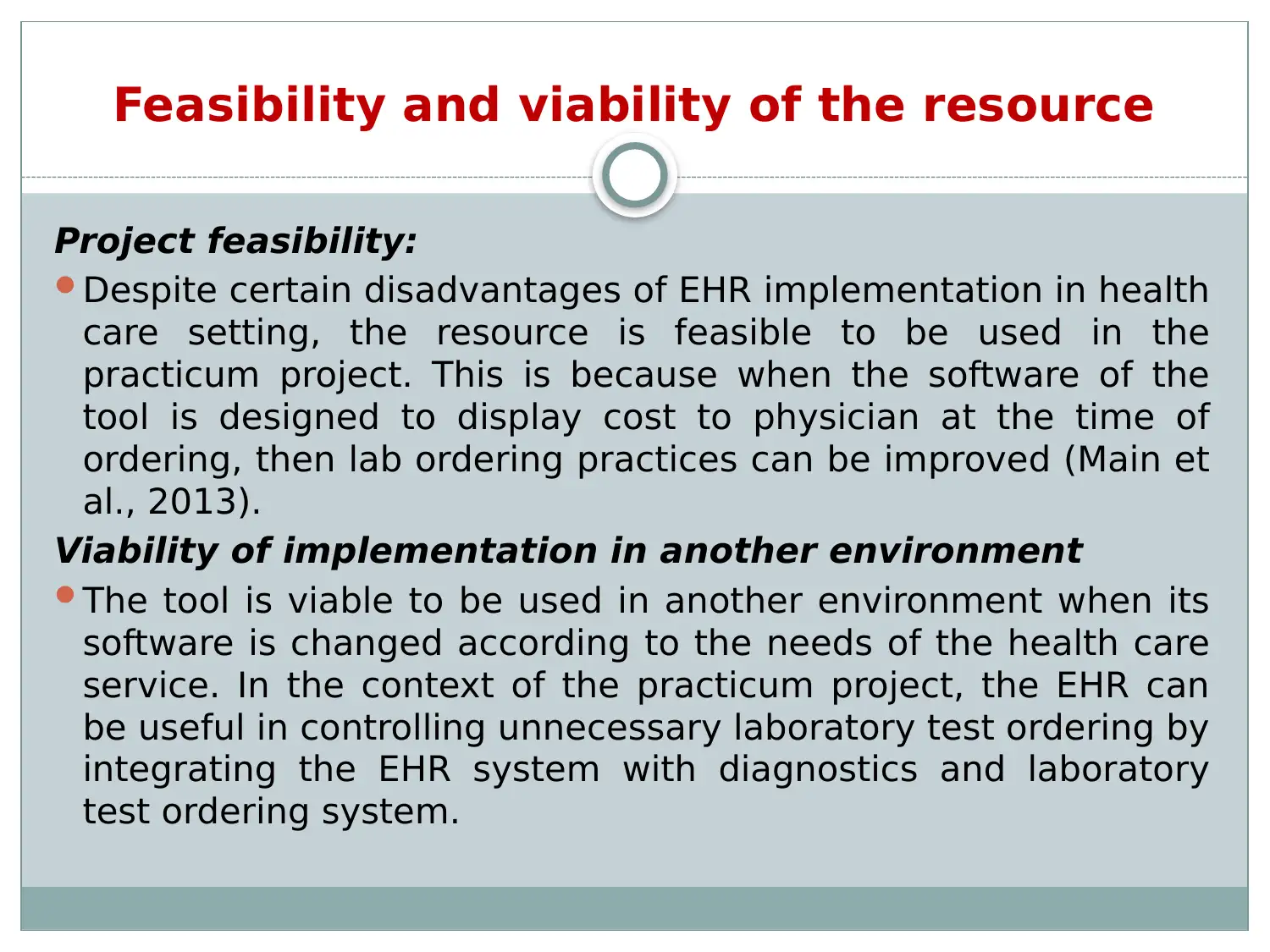
Feasibility and viability of the resource
Project feasibility:
Despite certain disadvantages of EHR implementation in health
care setting, the resource is feasible to be used in the
practicum project. This is because when the software of the
tool is designed to display cost to physician at the time of
ordering, then lab ordering practices can be improved (Main et
al., 2013).
Viability of implementation in another environment
The tool is viable to be used in another environment when its
software is changed according to the needs of the health care
service. In the context of the practicum project, the EHR can
be useful in controlling unnecessary laboratory test ordering by
integrating the EHR system with diagnostics and laboratory
test ordering system.
Project feasibility:
Despite certain disadvantages of EHR implementation in health
care setting, the resource is feasible to be used in the
practicum project. This is because when the software of the
tool is designed to display cost to physician at the time of
ordering, then lab ordering practices can be improved (Main et
al., 2013).
Viability of implementation in another environment
The tool is viable to be used in another environment when its
software is changed according to the needs of the health care
service. In the context of the practicum project, the EHR can
be useful in controlling unnecessary laboratory test ordering by
integrating the EHR system with diagnostics and laboratory
test ordering system.
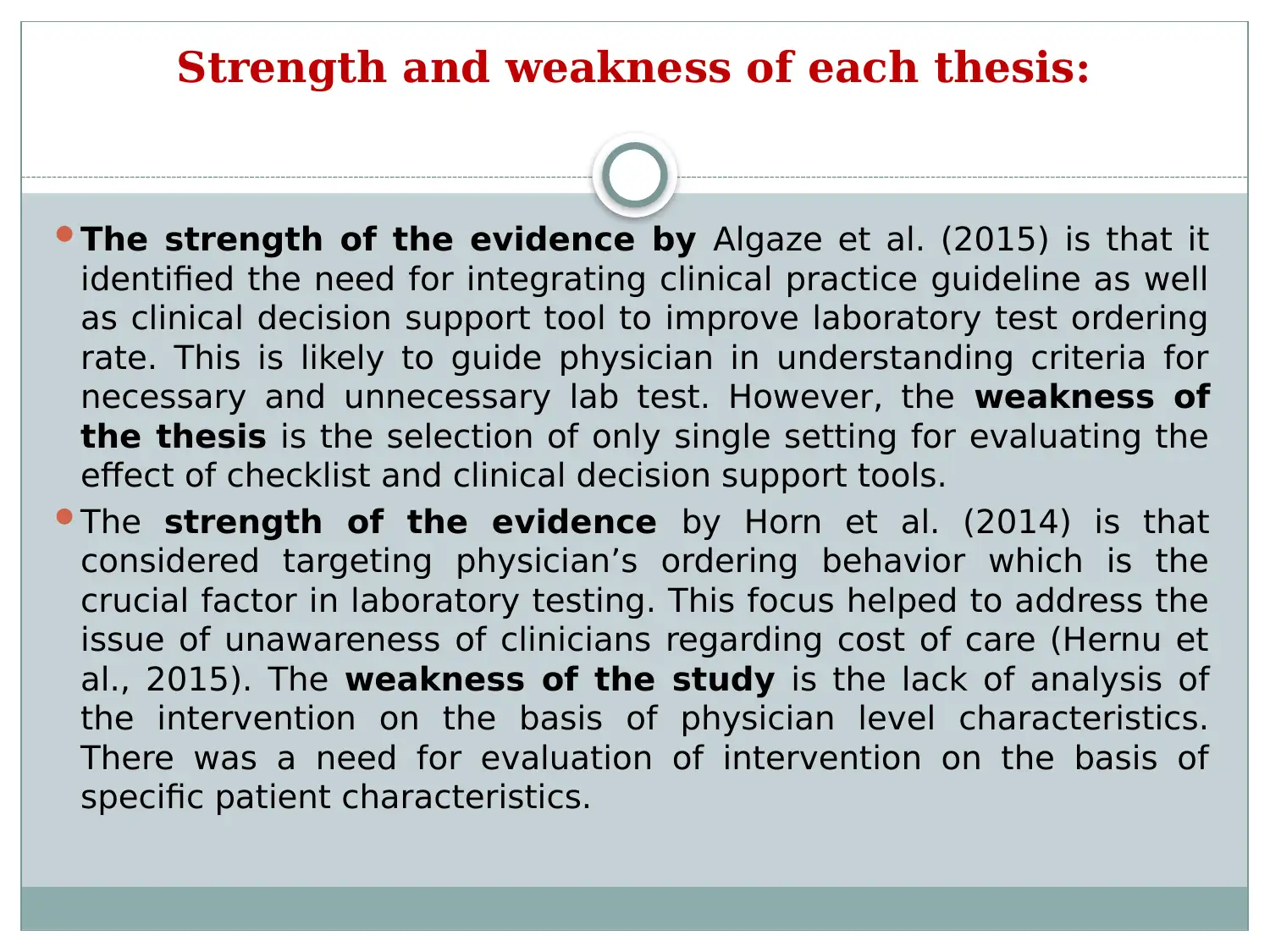
Strength and weakness of each thesis:
The strength of the evidence by Algaze et al. (2015) is that it
identified the need for integrating clinical practice guideline as well
as clinical decision support tool to improve laboratory test ordering
rate. This is likely to guide physician in understanding criteria for
necessary and unnecessary lab test. However, the weakness of
the thesis is the selection of only single setting for evaluating the
effect of checklist and clinical decision support tools.
The strength of the evidence by Horn et al. (2014) is that
considered targeting physician’s ordering behavior which is the
crucial factor in laboratory testing. This focus helped to address the
issue of unawareness of clinicians regarding cost of care (Hernu et
al., 2015). The weakness of the study is the lack of analysis of
the intervention on the basis of physician level characteristics.
There was a need for evaluation of intervention on the basis of
specific patient characteristics.
The strength of the evidence by Algaze et al. (2015) is that it
identified the need for integrating clinical practice guideline as well
as clinical decision support tool to improve laboratory test ordering
rate. This is likely to guide physician in understanding criteria for
necessary and unnecessary lab test. However, the weakness of
the thesis is the selection of only single setting for evaluating the
effect of checklist and clinical decision support tools.
The strength of the evidence by Horn et al. (2014) is that
considered targeting physician’s ordering behavior which is the
crucial factor in laboratory testing. This focus helped to address the
issue of unawareness of clinicians regarding cost of care (Hernu et
al., 2015). The weakness of the study is the lack of analysis of
the intervention on the basis of physician level characteristics.
There was a need for evaluation of intervention on the basis of
specific patient characteristics.
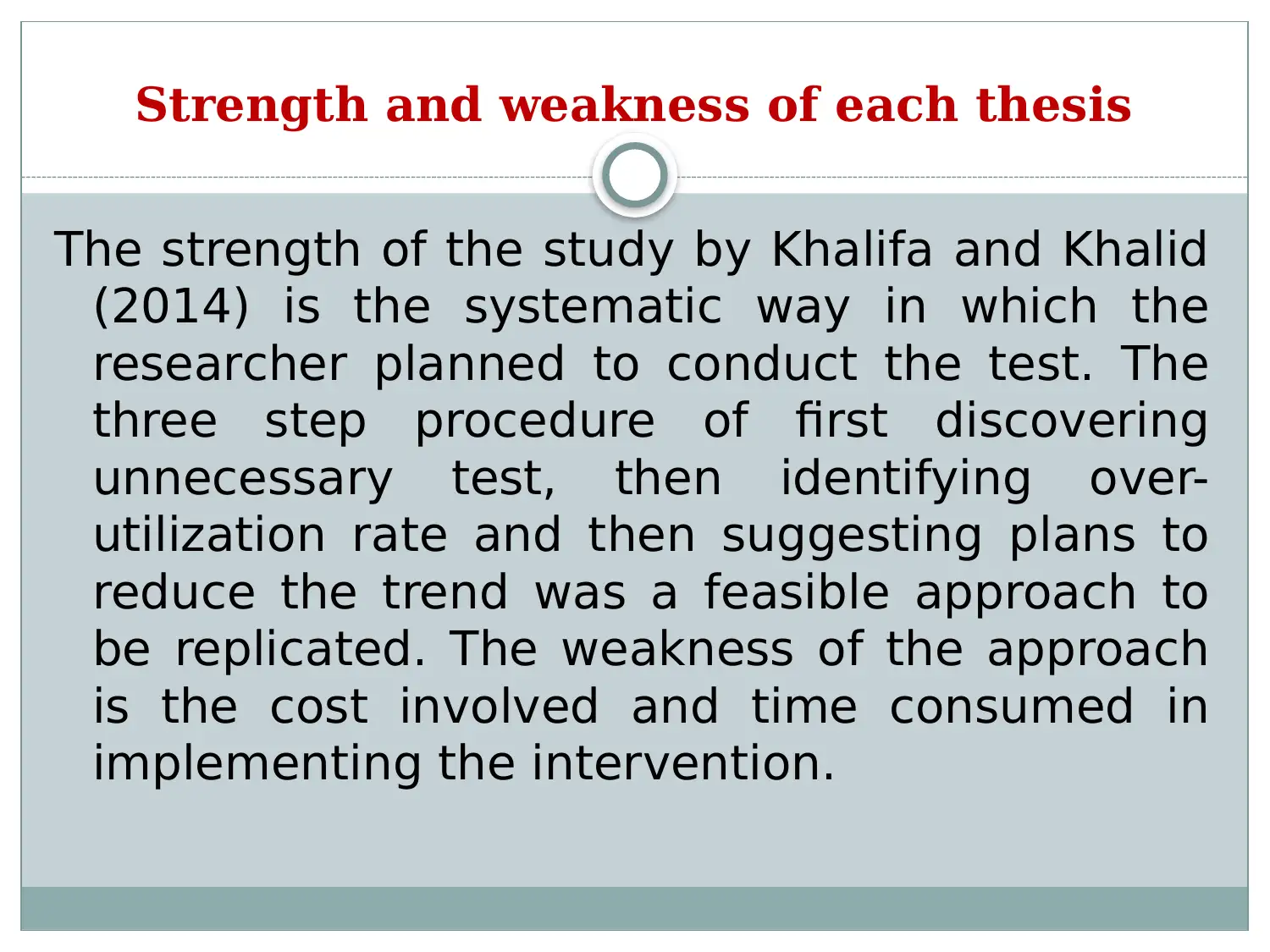
Strength and weakness of each thesis
The strength of the study by Khalifa and Khalid
(2014) is the systematic way in which the
researcher planned to conduct the test. The
three step procedure of first discovering
unnecessary test, then identifying over-
utilization rate and then suggesting plans to
reduce the trend was a feasible approach to
be replicated. The weakness of the approach
is the cost involved and time consumed in
implementing the intervention.
The strength of the study by Khalifa and Khalid
(2014) is the systematic way in which the
researcher planned to conduct the test. The
three step procedure of first discovering
unnecessary test, then identifying over-
utilization rate and then suggesting plans to
reduce the trend was a feasible approach to
be replicated. The weakness of the approach
is the cost involved and time consumed in
implementing the intervention.
Paraphrase This Document
Need a fresh take? Get an instant paraphrase of this document with our AI Paraphraser
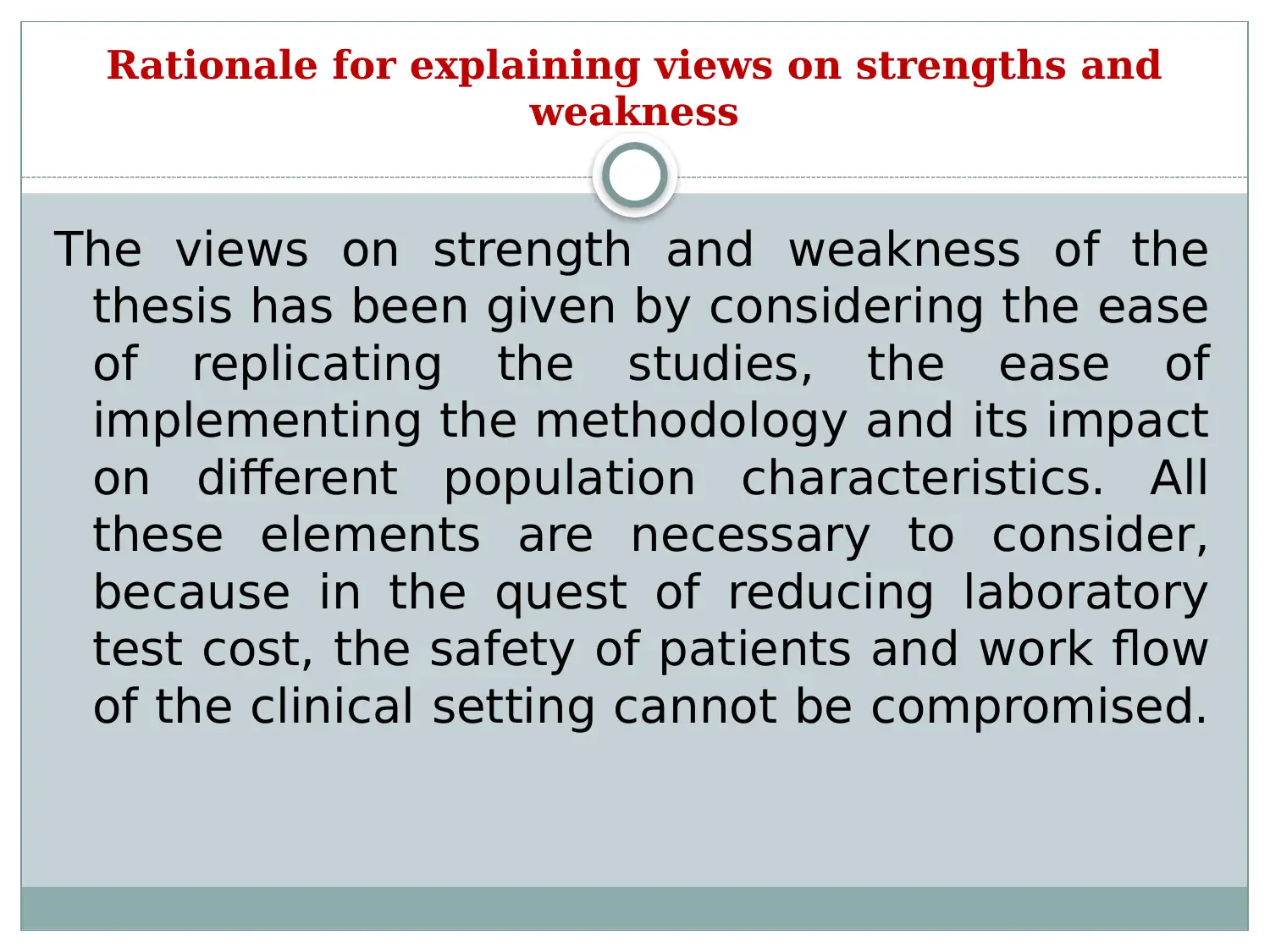
Rationale for explaining views on strengths and
weakness
The views on strength and weakness of the
thesis has been given by considering the ease
of replicating the studies, the ease of
implementing the methodology and its impact
on different population characteristics. All
these elements are necessary to consider,
because in the quest of reducing laboratory
test cost, the safety of patients and work flow
of the clinical setting cannot be compromised.
weakness
The views on strength and weakness of the
thesis has been given by considering the ease
of replicating the studies, the ease of
implementing the methodology and its impact
on different population characteristics. All
these elements are necessary to consider,
because in the quest of reducing laboratory
test cost, the safety of patients and work flow
of the clinical setting cannot be compromised.
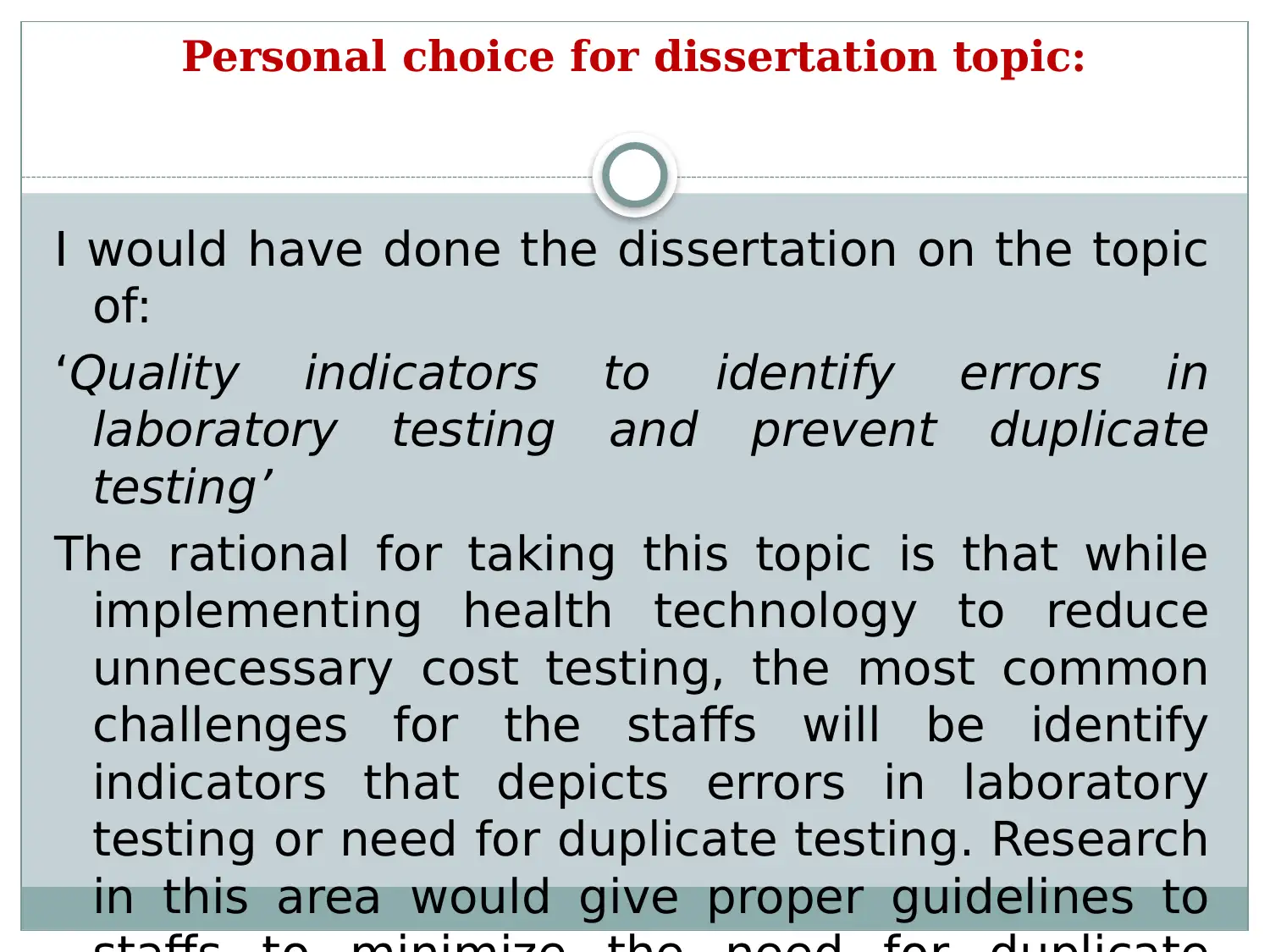
Personal choice for dissertation topic:
I would have done the dissertation on the topic
of:
‘Quality indicators to identify errors in
laboratory testing and prevent duplicate
testing’
The rational for taking this topic is that while
implementing health technology to reduce
unnecessary cost testing, the most common
challenges for the staffs will be identify
indicators that depicts errors in laboratory
testing or need for duplicate testing. Research
in this area would give proper guidelines to
I would have done the dissertation on the topic
of:
‘Quality indicators to identify errors in
laboratory testing and prevent duplicate
testing’
The rational for taking this topic is that while
implementing health technology to reduce
unnecessary cost testing, the most common
challenges for the staffs will be identify
indicators that depicts errors in laboratory
testing or need for duplicate testing. Research
in this area would give proper guidelines to
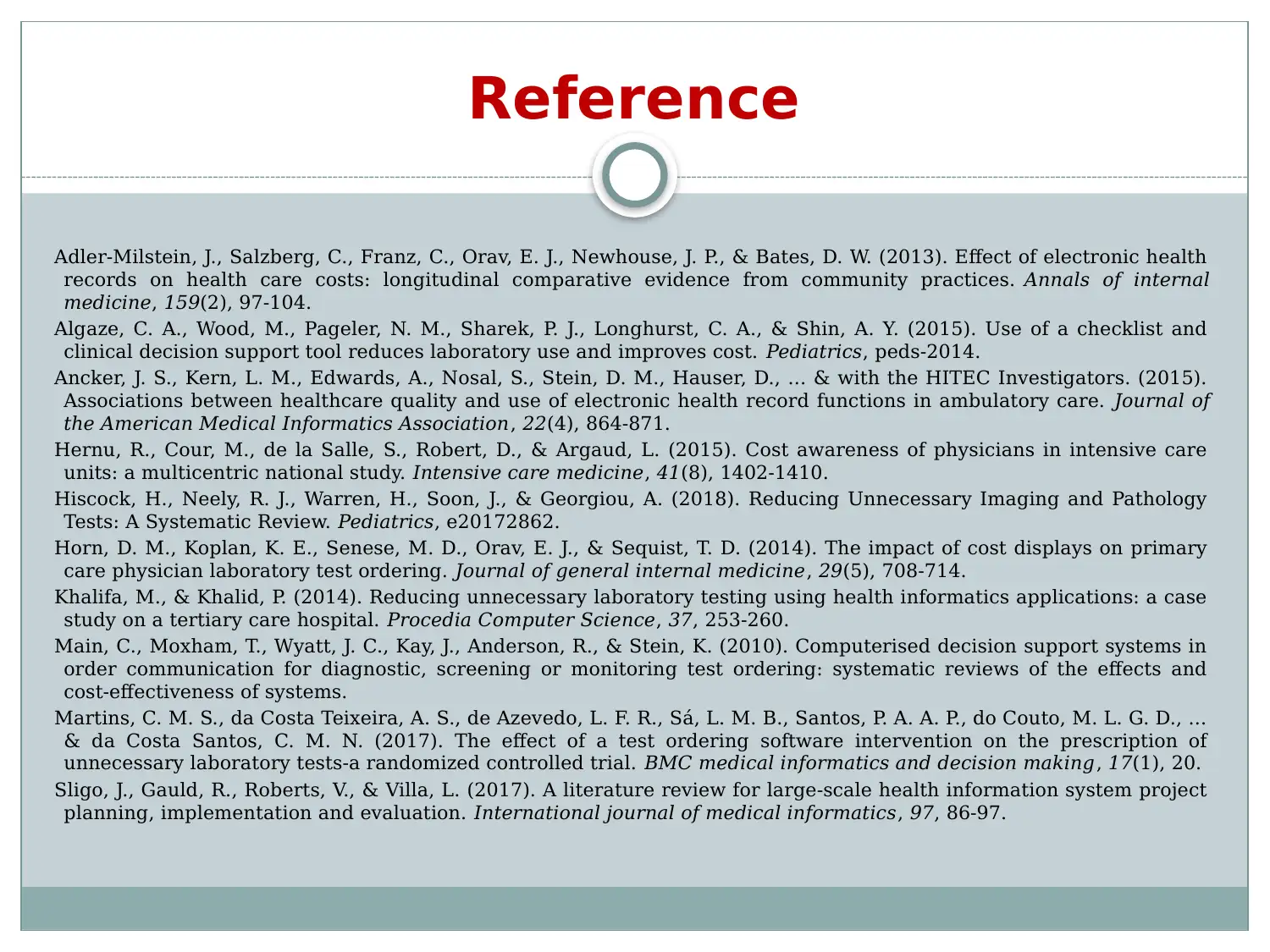
Reference
Adler-Milstein, J., Salzberg, C., Franz, C., Orav, E. J., Newhouse, J. P., & Bates, D. W. (2013). Effect of electronic health
records on health care costs: longitudinal comparative evidence from community practices. Annals of internal
medicine, 159(2), 97-104.
Algaze, C. A., Wood, M., Pageler, N. M., Sharek, P. J., Longhurst, C. A., & Shin, A. Y. (2015). Use of a checklist and
clinical decision support tool reduces laboratory use and improves cost. Pediatrics, peds-2014.
Ancker, J. S., Kern, L. M., Edwards, A., Nosal, S., Stein, D. M., Hauser, D., ... & with the HITEC Investigators. (2015).
Associations between healthcare quality and use of electronic health record functions in ambulatory care. Journal of
the American Medical Informatics Association, 22(4), 864-871.
Hernu, R., Cour, M., de la Salle, S., Robert, D., & Argaud, L. (2015). Cost awareness of physicians in intensive care
units: a multicentric national study. Intensive care medicine, 41(8), 1402-1410.
Hiscock, H., Neely, R. J., Warren, H., Soon, J., & Georgiou, A. (2018). Reducing Unnecessary Imaging and Pathology
Tests: A Systematic Review. Pediatrics, e20172862.
Horn, D. M., Koplan, K. E., Senese, M. D., Orav, E. J., & Sequist, T. D. (2014). The impact of cost displays on primary
care physician laboratory test ordering. Journal of general internal medicine, 29(5), 708-714.
Khalifa, M., & Khalid, P. (2014). Reducing unnecessary laboratory testing using health informatics applications: a case
study on a tertiary care hospital. Procedia Computer Science, 37, 253-260.
Main, C., Moxham, T., Wyatt, J. C., Kay, J., Anderson, R., & Stein, K. (2010). Computerised decision support systems in
order communication for diagnostic, screening or monitoring test ordering: systematic reviews of the effects and
cost-effectiveness of systems.
Martins, C. M. S., da Costa Teixeira, A. S., de Azevedo, L. F. R., Sá, L. M. B., Santos, P. A. A. P., do Couto, M. L. G. D., ...
& da Costa Santos, C. M. N. (2017). The effect of a test ordering software intervention on the prescription of
unnecessary laboratory tests-a randomized controlled trial. BMC medical informatics and decision making, 17(1), 20.
Sligo, J., Gauld, R., Roberts, V., & Villa, L. (2017). A literature review for large-scale health information system project
planning, implementation and evaluation. International journal of medical informatics, 97, 86-97.
Adler-Milstein, J., Salzberg, C., Franz, C., Orav, E. J., Newhouse, J. P., & Bates, D. W. (2013). Effect of electronic health
records on health care costs: longitudinal comparative evidence from community practices. Annals of internal
medicine, 159(2), 97-104.
Algaze, C. A., Wood, M., Pageler, N. M., Sharek, P. J., Longhurst, C. A., & Shin, A. Y. (2015). Use of a checklist and
clinical decision support tool reduces laboratory use and improves cost. Pediatrics, peds-2014.
Ancker, J. S., Kern, L. M., Edwards, A., Nosal, S., Stein, D. M., Hauser, D., ... & with the HITEC Investigators. (2015).
Associations between healthcare quality and use of electronic health record functions in ambulatory care. Journal of
the American Medical Informatics Association, 22(4), 864-871.
Hernu, R., Cour, M., de la Salle, S., Robert, D., & Argaud, L. (2015). Cost awareness of physicians in intensive care
units: a multicentric national study. Intensive care medicine, 41(8), 1402-1410.
Hiscock, H., Neely, R. J., Warren, H., Soon, J., & Georgiou, A. (2018). Reducing Unnecessary Imaging and Pathology
Tests: A Systematic Review. Pediatrics, e20172862.
Horn, D. M., Koplan, K. E., Senese, M. D., Orav, E. J., & Sequist, T. D. (2014). The impact of cost displays on primary
care physician laboratory test ordering. Journal of general internal medicine, 29(5), 708-714.
Khalifa, M., & Khalid, P. (2014). Reducing unnecessary laboratory testing using health informatics applications: a case
study on a tertiary care hospital. Procedia Computer Science, 37, 253-260.
Main, C., Moxham, T., Wyatt, J. C., Kay, J., Anderson, R., & Stein, K. (2010). Computerised decision support systems in
order communication for diagnostic, screening or monitoring test ordering: systematic reviews of the effects and
cost-effectiveness of systems.
Martins, C. M. S., da Costa Teixeira, A. S., de Azevedo, L. F. R., Sá, L. M. B., Santos, P. A. A. P., do Couto, M. L. G. D., ...
& da Costa Santos, C. M. N. (2017). The effect of a test ordering software intervention on the prescription of
unnecessary laboratory tests-a randomized controlled trial. BMC medical informatics and decision making, 17(1), 20.
Sligo, J., Gauld, R., Roberts, V., & Villa, L. (2017). A literature review for large-scale health information system project
planning, implementation and evaluation. International journal of medical informatics, 97, 86-97.
Secure Best Marks with AI Grader
Need help grading? Try our AI Grader for instant feedback on your assignments.

1 out of 17
Your All-in-One AI-Powered Toolkit for Academic Success.
+13062052269
info@desklib.com
Available 24*7 on WhatsApp / Email
![[object Object]](/_next/static/media/star-bottom.7253800d.svg)
Unlock your academic potential
© 2024 | Zucol Services PVT LTD | All rights reserved.